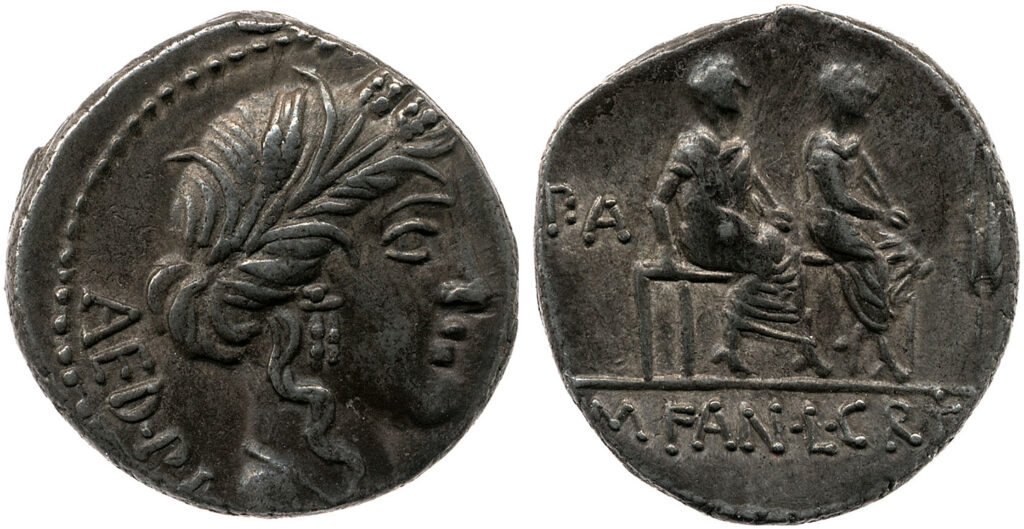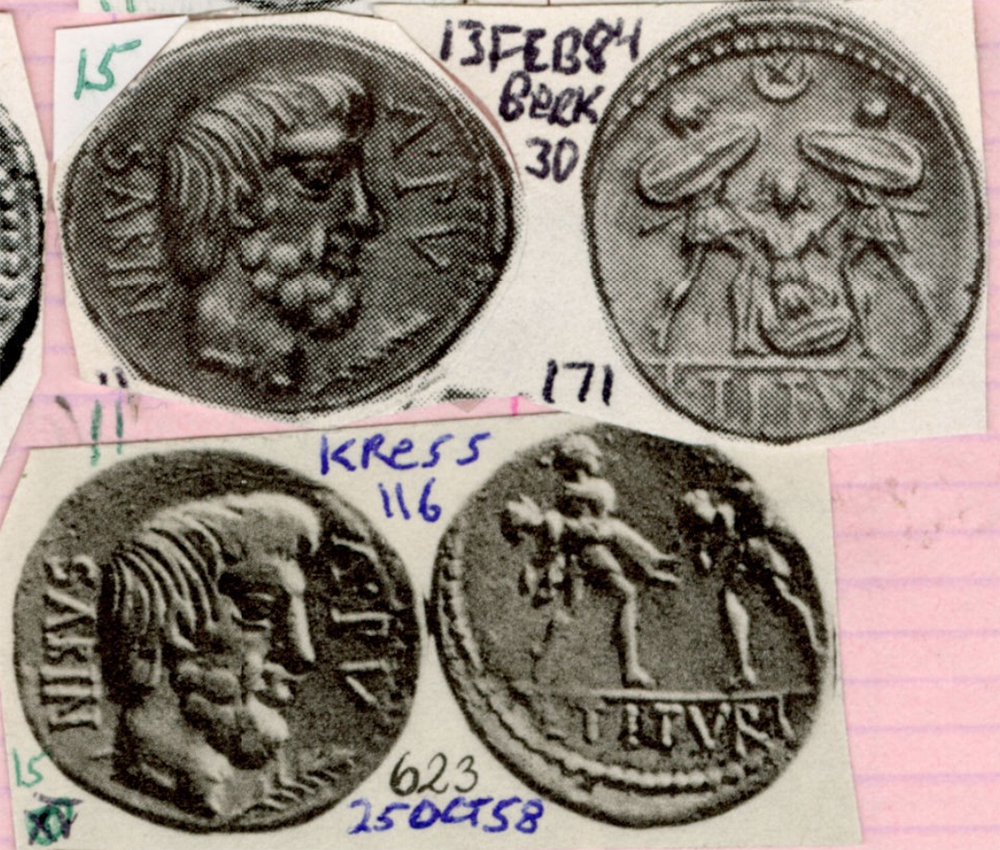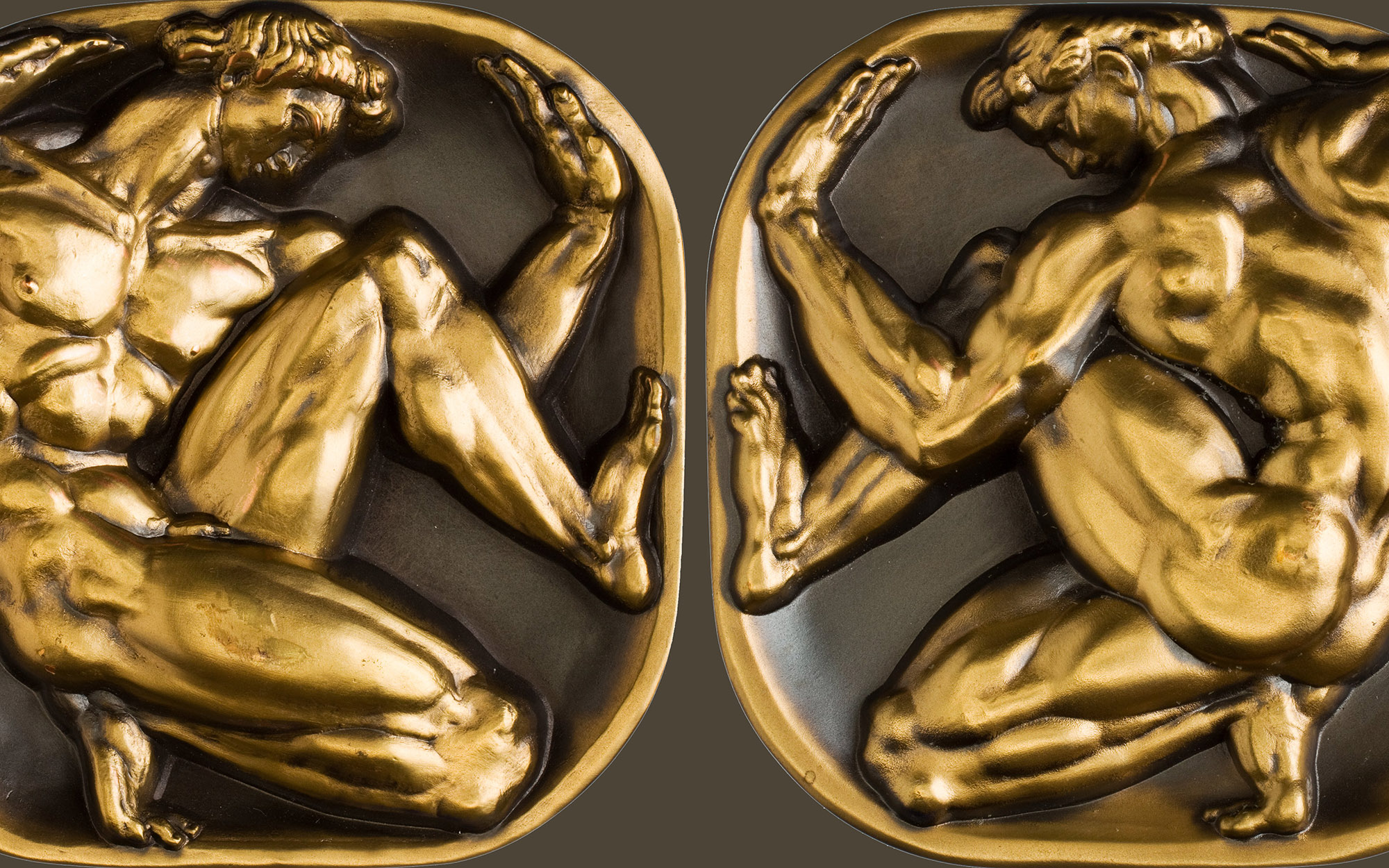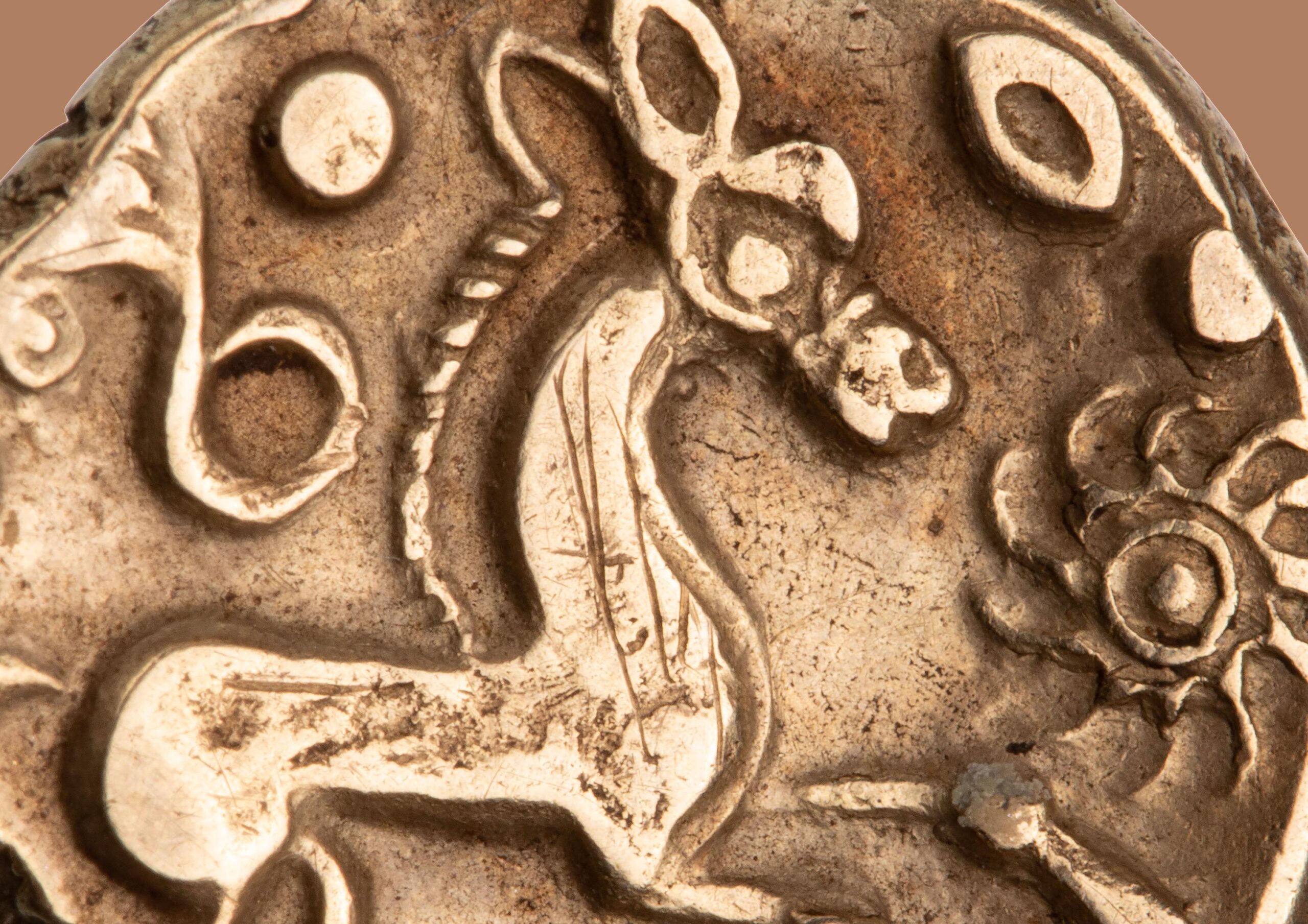Argento Publico and Die Sharing in Roman Republican Issues

The newest RRDP data release includes the following RRC types: 341/1, 341/2, 353/1, 353/2, and 352/1b. The last subtype is not included in Schaefer’s archive of Roman Republican dies, but specimens from Nomisma partner collections—already represented in CRRO—have been analyzed to supplement the previous release of 352/1a and 352/1c.

RRC 352/1b (fig. 1) and 353/2 (fig. 2) bear the special formula EX·A·P, denoting they were made ex argento publico. Although this formula must designate the coinage was produced from public funds, the exact implications of this are not clear. All Roman coinage was certainly produced from public funds, so why should some issues explicitly state this? There are at least seven issues that bear this formula in various forms:
RRC 322/1 C. Fabius, 102 BCE (EX·A·PV)
RRC 324/1 M. Licilius Rufus, 101 BCE (PV)
RRC 325/1 L. Sentius, 101 BCE (ARG·PVB)
RRC 328/1 P. Servilius Rullus, 100 BCE (P)
RRC 344/1c and 344/2c L. Titurius Sabinus, 89 BCE (A·PV)
RRC 352/1b L. Iulius Bursio, 85 BCE (EX·A·P)
RRC 353/2 Mn. Fonteius, 85 BCE (EX·A·P)

Michael Crawford also includes RRC 351/1, an issue of the aediles M. Fannius and L. Critonius from 86 BCE, which has P·A on the reverse (fig. 3). Harold Mattingly rejects this interpretation, instead suggesting P·A is for pecunia attributa/assignata since this issue may have been minted for the purpose of purchasing grain. This is suggested by the reverse design, featuring two togate magistrates seated right on a subsellium with an ear of grain to the right. This reverse closely recalls that of RRC 330/1 (fig. 4), which bears the legend AD·FRV·EMV EX·S·C (ad frumentum emundum ex senatus consulto, “for purchasing grain according to an order of the senate”).

The issue of Fannius and Critonius further emphasizes this purpose with the presence of Ceres wreathed with grain on the obverse (fig. 3).

Another possible special issue is that of L. Caesius, RRC 298/1 (112/1 BCE), which has the monogram AP (fig. 5). Crawford did not think this could be argento publico, though Charles Barlow did. Crawford instead interpreted the monogram as Ap(ollo) to identify the young male deity on the obverse who is seen hurling a thunderbolt, often interpreted as Apollo or Veiovis (cf. Wiseman 2009: 59-80). The later types Mn. Fonteius feature the same deity, marked by a thunderbolt below the obverse head, and some have the same monogram (RRC 353/1a-b, fig. 6).

Given the similarity of the two issues, it is likely the monograms should be interpreted the same way. Since part of the Fonteius issue is explicitly marked EX·A·P, it is possible the monogram is meant to be a(rgento) p(ublico) as well. Whether this would have been clear on RRC 298/1, which would then be the first such issue, is not certain. The interpretation of the monogram as Ap(ollo) is unusual since Republican issues rarely identify pictured deities. Monograms are also used, however, on the reverse of RRC 298/1 (fig. 5) to identify the Lares Praestites: LA – PRE for La(res) Pr(a)e(stites), which may support that interpretation of the obverse monogram as Ap(ollo). Indeed, the EX·A·P on part of the Fonteius issue may make it less likely that the AP monogram could also stand for a(rgento) p(ublico). It seems to me best to exclude RRC 298/1 from the list of special issues. Without the Caesius issue, the argento publico issues cluster in two groups: those from the years 102-101 BCE and those from 89-85 BCE.
Some scholars have argued that the formula is meant to indicate that these issues were made from a particular supply of bullion. Crawford suggested that the latest two issues of Bursio and Fonteius were minted from money left in a bequest to Rome from Ptolemy Alexander around 86 BCE. He has no similar explanation, however, for the earlier issues. In 1977, Barlow argued that argento publico issues were struck from funds from the sanctius aerariumwhich was reserved for funding campaigns against the Gauls. Barlow suggests that all issues featuring the special formula can be connected to conflicts with the Gauls, allowing the moneyers to tap the reserve funds of the sanctius aerarium, though he admits that they must have been able to use the funds for other purposes given the indications that the issue of Fannius and Critoniuswas for purchasing grain.
Although the idea that these special issues were struck from a particular source of bullion is intriguing, it is difficult to reconstruct a production process that would make this possible given that four issues have the special formula only on part of the issue (RRC 322, 344, 352, and 353). There are two possibilities: either it should be assumed the formula applies to the whole issue even though it is only explicitly stated on part, or the formula only applies to the part of the issue that is explicitly marked. The latter seems more likely, especially since the argento publico types typically make up only a small part of the issue (see tables 1-4). Indeed, RRC 352/1b and 353/2 are technically anonymous issues—where EX·A·P has replaced the moneyer’s name—though they are easily connected with Bursio and Fonteius by their designs. But this picture is complicated by the fact that most of these “partial” argento publico issues can now be shown to share dies with the rest of the issue. Only RRC 322/1b (EX·A·PV on obverse) does not seem to share dies since it has a reverse control marks while 322/1a does not. Although they have not yet been added to RRDP, Schaefer’s archive shows that RRC 344/1c and 344/2c (EX·A·PV on obverse) share obverse dies (fig. 7) and it is likely that each subtype also shares reverse dies with 344/1a-b and 344/2a-b respectively, although Schaefer has only analyzed obverse dies. RRC 352/1b (EX·A·P on reverse) shares obverse dies with 352/1a; and 353/2 (EX·A·P on obverse) shares reverse dies with 353/1d.

For the issue of Bursio (352/1), RRDP includes 311 obverse dies of all types, and 203 control-marked reverse dies (352/1c). The issue was more thoroughly analyzed by De Ruyter in 1966, who identified 460 obverse dies and 405 reverse dies across all types. For the EX·A·P type, De Ruyter identified seven reverse dies, while RRDP adds one for a total of eight. Although De Ruyter analyzed more specimens, the RRDP data provides a similar estimate using Esty’s formulae for the original number of obverse dies: 525-656 (table 1) compared to De Ruyter’s estimate of 556. The RRDP data also corresponds with De Ruyter’s estimate that the EX·A·P type made up only about 2% of the whole issue (tables 1-2).
| Obverse Dies | Coins | d1 | Estimated dies | Minus 95 | Plus 95 | Coverage | Approx. issue size |
| 311 | 612 | 141 | 587 | 525 | 656 | 77% | 10.5-13.1 million |
Table 1: Obverse die estimates for all types of RRC 352/1 (Esty 2011). Approximate issue size is based on an estimate of 20,000 coins struck on average per obverse die.
| Reverse Dies | Coins | d1 | Estimated dies | Minus 95 | Plus 95 | Coverage | Approx. issue size |
| 8 | 23 | 3 | 13 | 9 | 20 | 87% | 135,000-300,000 |
Table 2: Reverse die estimates for the EX·A·P subtype RRC 352/1b (Esty 2011). Approximate issue size is based on an estimate of 15,000 coins struck on average per reverse die.
The eight reverse dies of 352/1b are linked to 17 obverse dies. As De Rutyer has shown, these dies do not group closely enough to suggest they were used in one batch (only three are directly die-linked). Rather, it seems the EX·A·P dies were used somewhat sporadically alongside reverse dies without control marks (i.e. those of 352/1a). This seems to argue against the possibility that the EX·A·P coins could have been being struck from separate bullion than the rest of the issue. If these coins were minted from separate bullion, we might expect the minting process to be kept distinct to prevent accidental mixing of flans.
The EX·A·P issue of Mn. Fonteius shows a slightly different pattern. RRC 353/2 has 21 unique obverse dies (with EX·A·P). These are used in conjunction with 24 reverse dies of which at least 18 are also used with 353/1d. The obverse dies of 353/2 are die linked to only 20 obverse dies of 353/1d and seven obverse dies of 353/2 are directly die-linked to one another. This suggests that these dies may cluster more closely than those of 352/1b. Nevertheless, the EX·A·P coins of 353/2 must have been being minted simultaneously with those 353/1d, which again complicates the idea that they could utilize different bullion than the rest of the issue. Esty’s formulae provides an estimate of 24-36 obverse dies used to strike 353/2 (table 3), suggesting the EX·A·P issue made up roughly 8-10% of all Fonteius’ denarii (tables 3-4).
| Obverse Dies | Coins | d1 | Estimated dies | Minus 95 | Plus 95 | Coverage | Approx. issue size |
| 22 | 73 | 5 | 29 | 24 | 36 | 93% | 480,000-720,000 |
Table 3: Obverse die estimates for the EX·A·P type RRC 353/2 (Esty 2011). Approximate issue size is based on an estimate of 20,000 coins struck on average per obverse die.
| Reverse Dies | Coins | d1 | Estimated dies | Minus 95 | Plus 95 | Coverage | Approx. issue size |
| 393 | 1195 | 33 | 439 | 418 | 461 | 97% | 6.27-6.92 million |
Table 4: Reverse die estimates for all denarii of Mn. Fonteius, RRC 353/1 and 353/2 (Esty 2011). Approximate issue size is based on an estimate of 15,000 coins struck on average per reverse die.

Not all types that could share dies do. The issue of Q. Titius (RRC 341) is split into two types. Both show a Pegasus on the reverse standing right on a linear frame around the moneyer’s name, while the obverse features either a bearded head wearing a winged diadem (341/1, fig. 8) or the head of Liber wearing an ivy wreath (341/2, fig. 9).

Although these two types could theoretically share reverse dies, Schaefer found no shared dies between them. This suggests that the production of these two types was separated either chronologically (where one was minted only after the other was done) or physically (e.g. where each type was relegated to a separate anvil). This means the choice to mint the argento publico types of Bursio and Fonteius simultaneously with the rest of the issue was not an accident or coincidence.
It seems likely, therefore, that the argento publico formula does not indicate a particular supply of bullion. There is not space here to explore alternative explanations, but the next step will be to add the die analysis of RRC 344/1 and 344/2, scheduled for the next RRDP data release in May 2023. As noted, these types share obverse dies, which would, of course, not prevent them from being made from separate bullion. But if they also share reverse dies with their issues this would reflect an even more complex minting process than the issues of Bursio or Fonteius. A die analysis of all partial issues will hopefully shed more light on this question.




